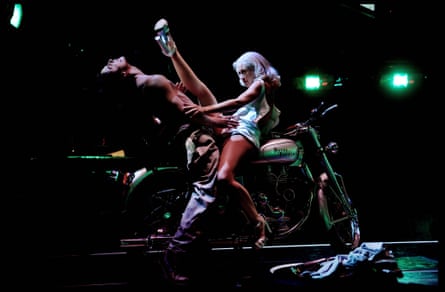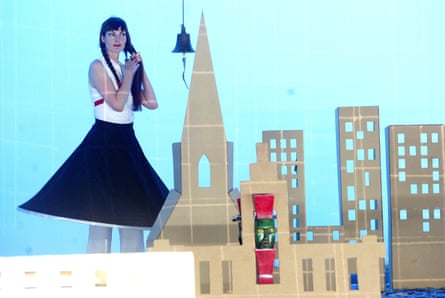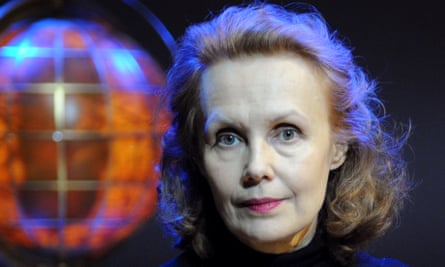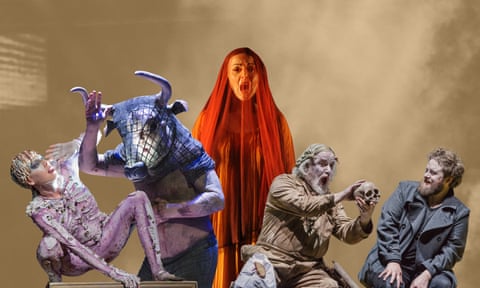25 Jennifer Walshe
XXX Live Nude Girls (2003)
Jennifer Walshe asked girls about how they played with their Barbie dolls, and turned the confessionals into an opera of horrors in which the toys unleash dark sex play and acts of mutilation. Walshe is a whiz for this kind of thing: she yanks off the plastic veneer of commercial culture by parodying then systematically dismembering the archetypes. KM
Read our review | watch a production from 2016 BIFEM
24 John Adams
City Noir (2009)
The Guardian’s product and service reviews are independent and are in no way influenced by any advertiser or commercial initiative. We will earn a commission from the retailer if you buy something through an affiliate link. Learn more.
Adams’s vivid portrait of Los Angeles, as depicted in the film noir of the 1940s and 50s, is a three-movement symphony of sorts, and a concerto for orchestra, too. It’s an in-your-face celebration of orchestral virtuosity that references a host of American idioms without ever getting too specific. It’s not his finest orchestral work by any means (those came last century), but an effective, extrovert showpiece. AC
Read our review | Listen on Spotify

23 James MacMillan
Stabat Mater (2016)
The prolific Scottish composer has made an impact on choral music, by drawing on his Roman Catholic roots, most recently in his Fifth Symphony, Le grand Inconnu, and in his Tenebrae Responsories. His Stabat Mater for chorus and string orchestra, premiered and commissioned by Harry Christophers and the Sixteen, caught the public imagination, its message direct, immediate, radiant and impassioned. FM
Read our review | Watch the world premiere performance at the Vatican
22 Linda Catlin Smith
Piano Quintet (2014)
She holds the fabric between the fingers, she tests the fibres. She leaves space around the material to consider it from this way and that, then sinks in deep. Catlin Smith’s music is slow and quiet but it’s also lush. More than any minimalist, she takes her cues from Couperin, Debussy and the paintings of Agnes Martin. The results are sparse, rugged and sensual; quiet does not have to mean soft. KM
Read our review
21 Max Richter
The Blue Notebooks (2004)
Written in the run-up to the 2003 invasion of Iraq, The Blue Notebooks is Max Richter’s meditation on violence and war, one that was recorded in three hours. The song cycle is linked by narration from Tilda Swinton, but the most compelling pieces don’t require words. Organum is a funereal organ solo, Shadow Journal a piece of ambient house, but the centrepiece is On the Nature of Daylight (since used on countless films and TV soundtracks), where ever-expanding layers of strings are used to heart-tugging effect. JL
Richter writes about his composition | Listen on Spotify.
20 Caroline Shaw
Partita (2013)
Caroline Shaw’s Partita, written for her own vocal octet Roomful of Teeth, is an explosion of energy cramming speech, song and virtually every extended vocal technique you can think of into its four “classical” dance movements. It might blow apart solemn, hard-boiled notions of greatness, but it has to be the most joyous work on this list. EJ
Read more here | Listen on Spotify.
19 Cassandra Miller
Duet for cello and orchestra (2015)
A slow cello pivots between two notes, a steadfast voyager on a road laced with spangly seduction (brass fanfares, ardent strings). The journey lasts half an hour; it sums up a resolute lifetime of holding the course in bright and heartsore times. Miller is a master of planting a seed and setting in motion an entrancing process, then following through with the most sumptuous conviction. KM
Read the review | Listen to an extract.
18 Brett Dean
Hamlet (2017)
The Australian Brett Dean, a viola player in the Berlin Philharmonic before concentrating on composition, found his operatic voice with Hamlet. An ingenious reworking of Shakespeare (libretto by Matthew Jocelyn) which opens with a fragmented “To be, or not to be…”, it was premiered at Glyndebourne in 2017 with Allan Clayton in the title role and Barbara Hannigan as Ophelia. FM
Read the review | Watch a trailer

17 Steve Reich
WTC 9/11 (2011)
It took the quintessential New York composer a full 10 years to process the horrors of September 11 and compose this dissonant threnody, one that sets Reich’s sawing strings against manipulated voices. The recordings of horrified air traffic controllers and eyewitnesses are spliced and looped, the tonalities of their speech replicated (sometimes almost mockingly) by the Kronos Quartet, before we reach a closure of sorts with a cantor’s prayer. JL
Read the review | Watch a live performance.
16 Rebecca Saunders
Skin (2016)
Rebecca Saunders’s music always makes a visceral and violent, yet sensually resonant, poetry. Composed in collaboration with the soprano Juliet Fraser, Skin takes inspiration from Samuel Beckett, turning the writer’s image of dust as “the skin of a room” into a 25-minute evisceration of the sounds that the soloist and ensemble can make. Saunders burrows into the interior world of the instruments, and inside the grain of Fraser’s voice – scrapes and screams, breaths and sighs – and finds a revelatory world of heightened feeling. TS
Listen to a live performance
15 David Lang
Little Match Girl Passion (2007)
Combine Hans Christian Andersen’s tale of the Little Match Girl with Bach’s St Matthew Passion, and you have one of the most original vocal works of recent times. Extracts from Andersen’s story and from St Matthew’s gospel are interleaved with closely woven vocal writing, that is sometimes unaccompanied, sometimes punctuated by discreet percussion and often comfortingly tonal and hauntingly affecting. AC
Read our review | Listen on Spotify
14 Pascal Dusapin
Passion (2008)
Dusapin’s opera reimagines the final colloquy of Orpheus and Eurydice, on the borderline between life and death, as a meditation on the idea of passion as an expression of desire and suffering. The score subtly alludes to Monteverdi and French baroque, but the sound world it creates is uniquely Dusapin’s own: tense, quietly mesmerising and austerely beautiful. TA
Read the review | Listen to the work

13 Olga Neuwirth
Lost Highway (2003)
David Lynch’s slightly baffling film – in which a jazz musician murders his wife, goes into a psychogenic fugue and becomes another person entirely – was perfectly suited for adaptation by this eccentric Austrian composer, whose genre-straddling work explores notions of identity. An immersive production, staged by the English National Opera at the Young Vic, used film, a chirruping electro-acoustic score and the terrifying, androgynous voice of David Moss to further confuse things. JL
Read our review | Listen to the work
12 Unsuk Chin
Cello Concerto (2009)
A series of concertos, for western and eastern solo instruments, runs like a spine through Unsuk Chin’s orchestral music. But the work for Cello is perhaps the most original and entertainingly disconcerting of all of them, cast in four brilliant movements that never quite conform to type, while doing everything expected of a concerto, in a fresh and unconventional way. AC
Read our review | Listen on Spotify
11 Gerald Barry
The Importance of Being Earnest (2012)
With the role of Lady Bracknell given to a bass, the row between Gwendolen and Cecily conducted through megaphones and accompanied by smashing glasses, and most of the text delivered with machinegun rapidity, this operatic take on Oscar Wilde isn’t for the faint-hearted. But somehow, it brilliantly captures the play’s absurdities while adding a layer of surrealism that is entirely Barry’s own. AC
Read our review | Listen on Spotify
10 John Luther Adams
Become Ocean (2013)
The monumental orchestral palindrome that made John Luther Adams an internationally renowned composer is a thrilling depiction of water in irresistible motion, in the tradition of music by Wagner, Debussy and Sibelius. But Adams’s intention is much more than mere description – it’s a warning of what lies ahead for us and our seas if we do not care for them. AC
Read our review | Listen on Spotify

9 Heiner Goebbels
Hashirigaki (2000)
A Gertrude Stein novel, Japanese folk music and the Beach Boys’ album Pet Sounds aren’t the most obvious sources for one of Goebbels’ uniquely personal fusions of words, music and image. But, as often in his theatre pieces, the most unlikely ingredients cohere magically, creating a witty, allusive dramatic world unlike any other, with the 1960s sounds counterpointing Stein’s rambling surrealism. AC
Read our review | Listen to a recording on YouTube
8 Jonathan Harvey
String Quartet No 4 (2003)
For live electronics and string quartet, this 2003 work is written in cycles rather than movements, with an idea of dying away, renewal and continuation. Harvey experiments with technology to discover new aural possibilities and keep the traditional form alive. He wrote all his quartets for the Arditti, knowing they would meet every challenge he put before them. The result is eloquent and lyrical. FM
Read the review | Listen to the work
7 Louis Andriessen
La Commedia (2009)
After collaborating with directors Robert Wilson and Peter Greenaway on previous stage works, Andriessen turned to Hal Hartley for his “film opera in five parts”, a series of reflections on episodes from Dante’s Divine Comedy. A Hartley film was part of the original staging, but Andriessen’s wonderfully polyglot score, with its host of historical references and exuberant embrace of jazz and folk music, stands on its own. AC
Read our review | Listen on Spotify

6 Kaija Saariaho
L’Amour de Loin (2000)
Set in 12th-century France, the Finnish-born Saariaho’s first opera, which premiered in Salzburg in 2000, is a haunting tale of a troubadour’s quest for idealised love, as well as a contemplation on life, longing and death. Based on La Vida breve by Jaufre Rudel, with a libretto by French-Lebanese writer Amin Maalouf, the music has medieval and Middle Eastern echoes but shimmers in Saariaho’s own distinctive and mesmerising voice.FM
Read our review | Listen on Spotify
5 Thomas Adès
The Tempest (2003)
It starts with a geometric storm and ends with a consolatory chaconne. Thomas Adès’s The Tempest was the catalyst for his creation of a musical language that is at once richly familiar and beguilingly strange. It was a piece that immediately fulfilled expectations for what Adès would do with the full resources of the Royal Opera House when it premiered in 2004 – and transcended them. TS
Read our review | Listen on Spotify
4 György Kurtág
Fin de Partie (2018)
Though it often seemed as if Kurtág would never complete the opera on Samuel Beckett’s End Game that he had obsessed about for more than half a century, it eventually appeared in the composer’s 93rd year. An austere, utterly faithful rendering of the original, mostly delivered in recitative, and reinforced with typically terse, wiry orchestral writing. It is a distillation of the uncompromisingly direct music that Kurtág has composed all through his career. AC
Read our review | Watch the production
3 Harrison Birtwistle
The Minotaur (2008)
After operas about Punch, Orpheus, Gawain and King Kong, the half-man half-bull protagonist of The Minotaur is perhaps the most sympathetic of Birtwistle’s “heroes”. His death scene, created especially for the bass John Tomlinson, is a majestic operatic set piece, the climax of a work in which the eruptions of orchestral violence are offset by music of lyrical beauty and pungent transparency. AC
Read our review.

2 George Benjamin
Written on Skin (2012)
George Benjamin’s first full-scale opera, with words by Martin Crimp, arrived in 2012 seemingly timeless in every way, its ultimately gruesome story told grippingly to a modern audience through Benjamin’s tense, precise and often glowingly beautiful score. Katie Mitchell’s thoughtful staging was only the start: no opera since has had so many different productions in so many theatres. EJ
Read our review | Watch a production
1 Hans Abrahamsen
Let Me Tell You (2013)
When the 21st century began, the idea that Hans Abrahamsen would compose one of the masterpieces of the next 20 years would have seemed extraordinary. At that time very little of his music had been heard for almost a decade – he had suffered a creative block that he’s since described as being “paralysed by the white paper”, and from which he eventually rescued himself by composing a series of arrangements, both of his own earlier scores and of pieces by others, including Bach and Debussy.
Born in 1952 in Copenhagen, Abrahamsen had begun his career as a member of a group of young Danish composers who reacted against what they saw as the overcomplexity of the European new music they heard and who sought a much simpler style. He explored minimalism and studied for a while with György Ligeti, and soon established himself as one of the younger European composers to watch, his works championed in the 1980s by conductor/composers such as Hans Werner Henze and Oliver Knussen. After early success came a long silence – he completed just one short piece in eight years, but he did return to composition with the piano concerto that he finished in 2000, in which he started to invent for himself a totally original and utterly personal sound world.
This list could just as easily be headed by the work that first exploited this newly invented world, Schnee, an extraordinary hour-long ensemble piece from 2008, as by the ravishing orchestral song cycle Let Me Tell You that followed it five years later. The intricate symmetries and microtonally tinged canons of Schnee define the icy, fragile world that Abrahamsen had been mapping out for himself, and which went on to provide the perfect environment for the settings of extracts from Paul Griffiths’s novel of the same name that he made for the songs.
Like Griffiths’s book, Let Me Tell You is a portrait of Ophelia, but one that tells her story from her perspective rather than from the way she is portrayed in Shakespeare’s Hamlet. It’s an operatic scene as much as a song cycle, one of soaring lines and shivering pianissimos, and which makes use of the stuttering repetitions, stile concitato, that Monteverdi introduced into opera four centuries ago to signify anger or anxiety. The vocal writing is astonishingly assured. It is hard to believe this was Abrahamsen’s first large scale vocal work, and it seems perfectly tailored to the soprano Barbara Hannigan, for whom it was conceived, and for her precious ability to soar ethereally and effortlessly above the sometimes forbidding, sometimes ravishingly beautiful soundscapes that the orchestra creates beneath her. There is the feeling, Hannigan has said of the cycle: “The music’s always been there,” and the sense of there being something timeless and utterly inevitable about Let Me Tell You gives it a very special power. AC
Listen to the work

Comments (…)
Sign in or create your Guardian account to join the discussion